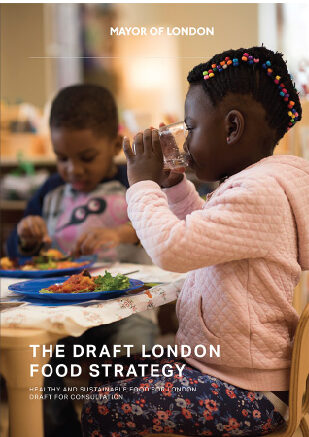The CUNY Urban Food Policy Institute’s recent report Food Policy in New York City Since 2008 Lessons for the Next Decade recommended that New York City develop a comprehensive, multi-year food plan for the city to ensure continued progress in reducing food insecurity and diet-related diseases, two big health burdens on New York City residents. The report suggested that New York could learn from similar global cities that have implemented food plans. The recently released Draft London Food Strategy provides three valuable lessons in food planning:
(1) The value of involving the public.
The London Food Strategy was developed by the Mayor’s Office and the London Food Board, a group of 19 volunteers who advises the Mayor of London and the Greater London Authority on food issues across the city with the goal of developing a better food system for all Londoners. Moreover, the strategy was released in draft form, inviting public comment and participation prior to its final release this summer with “ideas, evidence and expertise.” By opening the food planning process in New York City to resident and community participation, New York City could make food planning a more participatory process, give low income and vulnerable populations a greater voice in food planning and produce a document with many owners and advocates.
(2) The importance of articulating specific deliverables.
The strategy proposes six broad, cross-cutting goals that cities often include in their food plans: good food at home (reducing food insecurity); good food shopping and eating out (healthier food environments); good food in public institutions and community settings (better food procurement); good food for maternity, early years, education and health (supporting healthier practices); good food growing (supporting community gardens and urban farming); and good food for the environment –making the food system more sustainable.
However, the strategy also describes what the Mayor will do to “deliver” on these aspirations and identifies actions other organizations and ordinary Londoners can take to contribute to achieving the goals. These include:
- Funding food poverty action plans by London boroughs to help increase their understanding of factors creating food insecurity at a local level, and to help build local capacity to reduce and combat it.
- Reducing school holiday hunger in London by improving provision of holiday food for children from low-income families, through the Mayor’s Fund for London scheme Kitchen Social, which will engage 50,000 children and young people in London by 2020.
- Undertaking research to support the development of long-term solutions to the causes and impacts of food insecurity, including how we can measure its prevalence; and
- Promoting much higher numbers of employers paying the London Living Wage, recognizing that food poverty is partly due to low income.
Measurable goals and publicly accessible program data can ensure that policies are effective and serve as a tool to enable citizens to hold agencies accountable. New York City’s annual Food Metrics Report is a start, but a plan with detailed strategies and expected outcomes, and metrics that measure performance, would enable the city to evaluate and evolve its food programs and policies.
(3) The need to break down silos.
Clair Pritchard, the Chair of the London Food Board notes that:
“to help to embed this work in London policy, the positive role that food can play in our lives will be integrated across the full range of Mayoral strategies, and policies developed from them. These strategies include the draft London Plan, London Health Inequalities Strategy, the Mayor’s Economic Development Strategy, London Environment Strategy, the Mayor’s Transport Strategy, Culture for All Londoners Strategy, the Mayor’s Skills for Londoners Strategy, the Mayor’s Vision for a Diverse and Inclusive City, a Tourism Vision for London and a Vision for London as a 24-Hour City.”
In New York City, a food plan could be an opportunity to integrate food into a similar set of policies and plans, from neighborhood rezoning proposals to the city’s Green Infrastructure plan to Mayor De Blasio’s OneNYC, New York City’s plan to become the “most resilient, equitable, and sustainable city in the world.” Today these plans are not fully integrated and often isolate food systems planning from other planning initiatives.
In the Strategy’s introduction, Mayor Sadiq Khan acknowledges that London’s food system produces one of Europe’s highest rates of child obesity and a large population dependent on food banks despite the city’s prosperity. And, in many ways, New York City’s food policies are more advanced than those in many large, affluent cities. But London’s release of its food strategy moves it in a direction that New York City can learn from and build on.
